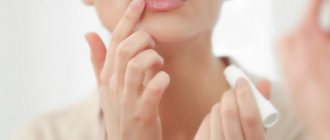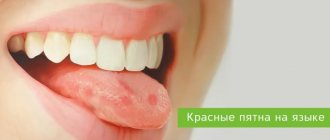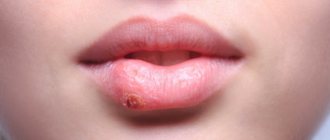The inflammatory process affecting the red border, mucous membrane and skin of the lips is called cheilitis. When caught, easily detachable scales appear on them, and in their place a reddish spot remains. At the same time, increased dryness, obsessive itching and burning occur on the lips. Symptoms persist for several days or years, appearing sporadically and disappearing as well.
Factors causing angulitis
Seizures (angulitis, angular stomatitis) are a type of skin lesion that is located in the corners of the mouth. The causes of this disease are as follows:
- increased reactivity of the immune system of an allergic nature, often seizures are one of the accompanying diseases, for example, with eczema, atopic dermatitis;
- the occurrence of some chronic infection in the body against the background of immunodeficiency;
- diabetes mellitus (the mechanism is the same as during the formation of a diabetic foot, when tissue trophism is disrupted);
- hypo- and vitamin deficiency, especially for B vitamins;
- long-term and intensive antibacterial therapy (destroys beneficial microflora, as a result of which opportunistic microflora is activated);
- serious changes in hormonal levels, physiological (adolescence, pregnancy) and pathological (with disturbances in the functioning of the endocrine glands).
Causes of cheilitis
The inflammatory process can begin for multiple reasons. One of the most common of them is mechanical injuries: for example, accidental biting can cause inflammation.
The development of the disease can also be provoked by:
- unfavorable environment (people who spend a lot of time outdoors and are exposed to wind, frost and other weather conditions are more likely to suffer from cheilitis);
- aggressive action of cosmetics or an allergic reaction to some of their components;
- lack of vitamin B2, which is responsible for the division and growth of epithelial cells;
- diseases of the gastrointestinal tract, liver, lack of immunity.
Varieties of jam
Thus, angulitis can be an allergic inflammation, or a bacterial infection that occurs against the background of weakened immunity and/or impaired trophism of the skin in the corners of the mouth. Allergic seizures are easily identified - they occur after eating some food that is an allergen for the patient. Or the food itself may be overly irritating (spicy, sour). Allergic seizures are often a concern in childhood, when the level of allergic reactivity is especially high. In all other cases, the development of seizures is associated with the addition of an infection:
- Streptococcal infection. It begins with the formation of a vesicle in the corner of the mouth, which quickly resolves, leaving a small, slightly bleeding erosion. The erosion quickly heals with a purulent-bloody crust. The crusts may peel off and grow back. The jam when moving your mouth can be a little painful. Often develops against the background of bacterial tonsillitis in children.
- Candida infection (opportunistic fungi of the genus Candida). Here the erosion is not covered with a crust, but is framed by softened epithelium. An easily removable grayish film may appear on the wound. This jam is less noticeable when the mouth is closed.
- Less commonly, seizures are caused by viruses. If this happens, then with a 95% probability it is a herpes virus type 1 or 2.
The choice of drugs depends entirely on the etiology of angulitis. The nature of the pathology is determined by a dermatologist during a clinical examination, and the exact infectious pathogen is identified by taking a scraping.
Cheilitis - symptoms and treatment
The lip consists of three sections: cutaneous, transitional (red border of the lips) and mucous. Deep in the lips is the orbicularis oris muscle, which is responsible for their movements.
The cutaneous section is similar to normal skin: it contains hair, sweat and sebaceous glands, and keratinizing epithelium. In the keratinizing epithelium, scales are formed that protect the underlying layers of the skin. Over time, the scales fall off and are replaced by new ones.
The transitional region is different from the skin: there is no hair and sweat glands, the sebaceous glands remain only in the corners of the mouth. They perform a protective function so that open areas of the lips do not dry out. The keratinizing epithelium gradually turns into non-keratinizing epithelium, i.e., protective scales do not form on it.
In the mucous membrane, the sebaceous glands completely disappear, the epithelium becomes non-keratinized and small salivary glands appear.
Cheilitis can be accompanied by various manifestations: scales, crusts, cracks, erythema, blisters and erosion.
Scales in cheilitis are silvery plates that form after the death and rejection of a layer of surface tissue. The keratinizing epithelium can only be seen under magnification, but the scales are immediately noticeable. They can also appear on non-keratinizing epithelium if its cells have died.
The next pathological element is the crust. It is similar to a scale, but is formed if the death of surface cells is complicated by inflammation. Fluid containing immune cells emerges from the blood vessels, and the scales swell and turn into crusts. Due to the fact that there is more fluid between the cells, the adjacent tissues increase. They begin to compress pain receptors, and pain occurs.
Cracks are painful defects in the form of straight lines. They occur when lips become dry and lose their elasticity. They can appear due to bad habits such as smoking and lip biting, as well as burns, physical and chemical trauma.
Cracks can heal and reappear after some time, often in the same place. This cycle can be seasonal, for example worsening in winter due to adverse weather conditions or weakened immunity.
Erythema is a red spot without clear boundaries, most often due to allergies. Usually painless, but sometimes its sensitivity increases slightly.
A vesicle is a small formation above the surface of the skin or mucous membrane. Inside it there is a liquid - blood plasma with living and dead immune cells and microorganisms; in more severe cases it is called exudate, or pus. The appearance of fluid is often preceded by an infection, to which the body's immune cells react.
Erosion is a pink or red formation that appears at the site of a large burst bubble. It is painful when touched. It differs from erythema by clearly defined boundaries and location below the level of the skin or mucous membrane, forming a small “pit”.
Treatment of allergic angulitis
If the seizure is of an allergic nature, then antihistamines are first prescribed. The generation of the drug does not play a special role here. It’s just that Suprastin (Chloropyramine, 1st generation) causes severe drowsiness and sometimes headache, and its effect may weaken over time (allergic resistance). Whereas Erius (Desloratadine, 3rd generation) not only competitively binds to histamine receptors, but also inhibits the synthesis of histamine itself. And the side effects are much less pronounced. The “golden mean” is Loratadine - a 2nd generation drug that has almost no side effects, is almost as effective as Erius, but is several times cheaper.
In case of severe allergic inflammation, short-term use of hormonal ointments is permissible: Akriderm, Sinaflan, Advantan, Fenistil, etc. However, for children under 12 years of age, hormonal ointments are prescribed only as a last resort. As a softer analogue of hormonal ointments, you can use Vishnevsky's liniment. But not longer than 10 days, and care must be taken to ensure that the child does not accidentally lick off the applied drug. We must remember that there is always a risk of infection joining allergic inflammation. Considering that children often comb out bumps with unwashed hands.
Angulitis during pregnancy: how to get rid of it
Pregnant women are very vulnerable to various infections. Risk factors in this case are vitamin deficiency and increased stress on the body.
Causes of angulitis during pregnancy:
- licking lips in the cold;
- allergic reactions;
- caries;
- dry lips;
- general decrease in immunity.
On our website Dobrobut.com you will find more information on this issue. Here you can make an appointment with a doctor, who will tell you how to get rid of the jam and which ointment is best to use in your case.
Treatment of infectious angulitis
When angulitis develops due to infection, then the appropriate remedy is needed. Fukortsin is often prescribed as the first line, which has both antibacterial and antifungal activity, and forms a long-term, protective film at the site of damage.
In eliminating bacterial infections, Metrogyl Denta gel, containing Metronidazole and Chlorhexidine as active ingredients, has gained great popularity. Older, but also effective combined broad-spectrum agents are ointments: Methyluracil ointment and Trimistin. Tetracycline ointment and Levomekol are excellent against streptococcal infections.
If the infection is of a fungal nature, then the main treatment is antifungal ointments: Levorin, Nystatin, sulfur-salicylic, and Clotrimazole. Acyclovir is most often prescribed against herpes lesions in the mouth.
Diagnosis of the disease
Unfortunately, patients with angulitis very rarely turn to a specialist for help, but in vain. After all, the acute form of the disease is easier to cure, thereby preventing the disease from becoming chronic.
Required research:
- general blood and urine tests;
- blood sugar test;
- biochemical analysis and liver tests;
- ELISA blood test for herpes viruses;
- blood test for syphilis;
- Ultrasound of the abdominal cavity.
Consultation with highly specialized specialists may also be required.
Additional measures and prevention
In addition to therapy that eliminates the cause, auxiliary therapy is required to prevent relapses. Vitamin ointments Panthenol and Bepanten, providing the skin with additional pantothenic acid. Vitaon (one of Karavaev’s balms) is a complex complex based on plant substances (essential oils, calendula, fennel, rose hips, pine, chamomile, mint, St. John’s wort, etc.). Vitaon accelerates regeneration processes, inhibits the development of inflammation and has a slight antiseptic effect. Zinc paste creates good protection against excessive evaporation of moisture from the epidermis and protects against re-entry of microorganisms. And of course, you need proper, fortified nutrition. Skin health is primarily affected by a lack of vitamin B2 in food.
Cheilitis in children
Depending on the age of the child, he may experience a certain type of cheilitis.
Newborns suffer from a catarrhal disease caused by the prolonged presence of a pacifier or bottle in the mouth. Plus, saliva accumulates on the nipples of the lips, irritating sensitive baby skin.
If the disease is ignored, hoping that it will go away on its own, cheilitis will develop into an exfoliative form, accompanied by the formation of scales, which the child will not be able to remove himself (parents are highly discouraged from interfering in this process, since attempts to tear off the crusts can cause cracks, which will only aggravate the situation ).
Constant sucking of the mother's breast is an equally common cause of the development of the disease: during feeding, cracks form on the nipples, into which bacteria penetrate, which causes cheilitis.
Nutrition as a treatment for seals in the corners of the lips
Whatever the reason causes cracks to appear in the corners of your lips, in parallel with the main treatment, you will need to reconsider your lifestyle. Why did your immune system fail? Are you getting adequate sleep? Are you walking enough? Are you eating right?
Vitamin deficiency is one of the most common causes of angulitis, and it is much easier to prevent it than to then undergo a long course of vitamin therapy. You can easily make up for the lack of nutrients from the foods that make up your daily diet.
Firstly , as soon as the spots appear in the corners of your mouth, immediately give up alcohol, carbonated drinks, pickled, salty, sour, spicy foods. Secondly , try to include foods enriched with riboflavin (vitamin B2) in your menu every day.
It can be:
- rice (it must be unpeeled);
- nuts (any);
- legumes;
- green leafy vegetables;
- bran;
- fish;
- eggs (there is a lot of riboflavin in the yolk);
- avocado;
- cheese;
- poultry meat.
It is a good idea to supplement these products with those enriched with vitamin E (tocopherol). They will also help eliminate this scourge faster. Your table should have:
- cabbage (all varieties);
- any vegetable oils (preferably unrefined);
- oatmeal;
- corn (preferably fresh).
Such a unique diet for sticking in the corners of the lips will speed up recovery and make it easier to endure the hardships of the disease. Be sure to use it in parallel with the medication course prescribed by your doctor. You will also have to stop smoking during therapy, because it can delay treatment indefinitely and contribute to the formation of painful and unpleasant ulcers.
Sleep at least 8 hours a day, breathe fresh air and move more. These simple basics of a healthy lifestyle leave no chance for any infections, including angulitis. Unfortunately, it is not always possible to seek help from a doctor in a timely manner. In such cases, at the initial stage of the disease, traditional medicine can come to the rescue.








